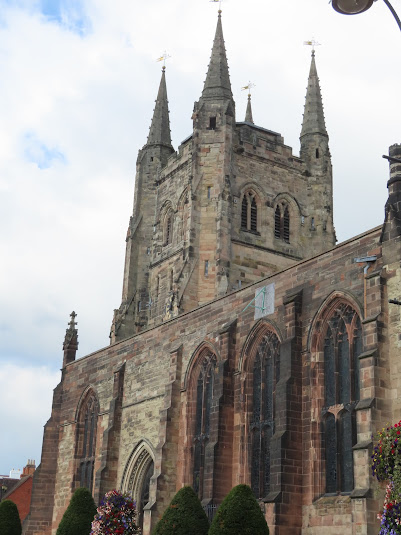Lazy day today with a wander around Tamworth with a tourist mobile phone guided walk, lunch and a trawl of the charity shops.
The sun was shining on the trees by our moorings as we went ashore to the pictures last night.
The walk from the moorings to the town centre take you through the park next to the River Anker and bring you out at the base of the castle. The gardens are always well tended on these terraces and were installed in 1940. However the bandstand was there from 1900 and is still used today. The castle was first there from the original Motte and Bailey from 1070AD. It is now earned by Tamworth Borough Council after they bought it in 1897 for £3,000.
St. Editha's Church is on a high point in the town. The original 963 church with Norman additions burned down with much of the rest of the town in 1345. It's rebuilding was used to revitalise the town after the fire, the Black Death and a famine. The church has some lovely stained glass. The lady told us that some of it Pre-Raphelite. She also told us that Andrew Lloyd Weber had been to see it as he is a lover of all things Pre-Raphelite. He saw that the glass was not protected from external damage so raised the money for the grills to be erected.
In the church yard I saw this monument to Edward Farmer the writer of the poem 'Little Jim'. see here. I think I am going to learn it by heart as it is great to say out loud, and is a real tear jerker. It Turns out the Edward, or Ned as he was known was a batchelor and died age 70 as the head of the Detective department of the Midland Railway Co. police department. He had gone to work via the train from Tamworth to Derby and had a stroke at his office. He was taken to the Midland Hotel where he died later.
When I first saw this building I thought it would turnout to be an old cinema. In fact it was the old Tamworth and District Electrical Supply Co. new showrooms that were opened on 28th December 1936. They moved from further down Church Street where they had been since 1924. What a lovely Art Deco building.
We wandered up Colehill and saw a pub and gin bar called Hogarth's. As we stood outside I saw the painted window over the door and above, the plaque on the wall. Edwin Gooderidge Ashwood bought the the old building in 1882 when it was just a small rundown beerhouse. He had followed his father as a carpenter/joiner, training under his father. After his fathers death he carried on the trade but also started to run the beerhouse. Over the years he removed the old building and rebuilt it in 1894 to the fine building you see today. It was where all the Societies and groups met and had their meetings. It even had an air shooting club that had competitions there. His mother lived nextdoor as a shopkeeper and men's barbers. By 1901 Edwin had retired, aged 46 and moved to Wigginton/Hopwas. He had been elected to Tamworth District Council and then Wigginton. When he moved to the country he became a farmer and when he died in 1934 he left over £9,000.
To the left is the basin that was home to the Samuel Barlow canal long distance haulage business. You can see that the triangle concrete structure must be the buffers for the line that can be seen running along the side of the basin from this 1938 OS map.
We have seen this sign before but I had a look to see what the story was. Charlotte was born in Maidenhead and started work as a nurse maid age 13 to a Doctor's family in London. By the time she was 23 she joined the household of Duke and Duchess of York. She took over as head nurse when the previous person had been dismissed. When the Duke became King Charlotte Jane Bill stayed at Sandringham with Prince John who had been born in 1905 and had several medical problems, epilepsy and austim/learning difficulties. He died in his sleep in 1919 and Charlotte, or Lala as the children called her, was devastated. For her devotion to the children, and especially Prince John, she was given a grace and favour house on the Sandringham estate. It seems that she never married but she continued to assist at many royal births, including Princess Elizabeth in 1926. Queen Elizabeth.
On the way to Alvecote I spied this brick wall in the trees. I thought it may be a railway line but I think it was this basin. I can't see that it served any particular factory of works, but it is close to the Tamworth Colliery so it may be just a transhipment point for coal not sold direct.
The basin that now houses Narrowcraft was built for the Tamworth Colliery. This OS Map is from 1938/39. The pit became the entrance for the Polley Hall Colliery and all in the area were closed in 1965.
















No comments:
Post a Comment